Table of Contents
This article identifies ten osteoporosis exercises to avoid. (The term “osteoporosis exercise contraindications” is the medical term for “osteoporosis exercise to avoid”). In addition to these osteoporosis exercise precautions, I cover several yoga and Pilates exercises to avoid if you have osteoporosis.
Introduction to Osteoporosis Exercises to Avoid
Research and clinical studies show that flexion of the osteoporotic spine, especially in situations where force is applied, can lead to compression fractures of the vertebrae. Unfortunately, this scientific fact is not well known within the fitness community and, as a result, there are Personal Trainers (and some medical professionals!) encouraging exercises (like traditional crunches) that cause flexion and potentially put you at risk of a compression fracture.
Ten Osteoporosis Exercises to Avoid
The following are ten osteoporosis exercises to avoid:
- Crunches
- Chest Fly
- Chest Press
- Knee Extensions
- Lat Pulldown (behind the head)
- Seated Rows
- Toe Touch with a Twist (Rotation)
- Hamstring Stretches
- Back Stretches
- Cardiovascular Exercises that encourage flexion
Each of these is described in detail in the section below.
Unfortunately, many fitness professionals do not know how to modify exercises programs for people with osteoporosis. It is up to you to take care of your bone health and either avoid the exercise or ask your Personal Trainer make appropriate modifications.
The book Exercise for Better Bones has a comprehensive list of osteoporosis exercises to avoid (or modify) with accompanying descriptions and photo illustrations. It also has (and this is important) exercises you should do if you have osteoporosis based on your activity level and risk of fracture. Consider sharing your copy with your Personal Trainer or encourage them to purchase their own.
Osteoporosis Exercise Contraindications
Clients with osteoporosis come to my clinic for a bone-friendly exercise program. These clients find that some Personal Trainers do not adequately considered their bone health when assigning them an exercise program. In fact, some of the exercises increase their risk of a fracture!
Flexion, Rotation, Osteoporosis and Exercise Contraindications
People with osteoporosis, osteopenia and low bone density should avoid movements and exercises with flexion and the combination of flexion and rotation. Many of the osteoporosis exercises to avoid, covered in this blog, encourage either flexion or rotation (or, in some cases, both movements).
Many of these exercises have been with us for years. You have probably done a number of them in your past (hopefully for the last time!). You may be surprised by some of the exercises I am asking you not to do.
Let’s start with the most popular of exercises: the traditional crunch or sit-up – used by many people to build their abs.
Exercise Recommendations for Osteoporosis
Exercise is an essential ingredient to bone health. If you have osteoporosis, therapeutic exercise needs to be part of your osteoporosis treatment program.
But what exercises should you do and which ones should you avoid? What exercises build bone and which ones reduce your chance of a fracture? Is Yoga good for your bones? Who should you trust when it comes to exercises for osteoporosis?
A great resource on exercise and osteoporosis is my free, seven day email course called Exercise Recommendations for Osteoporosis. After you provide your email address, you will receive seven consecutive online educational videos on bone health — one lesson each day. You can look at the videos at anytime and as often as you like.

I cover important topics related to osteoporosis exercise including:
- Can exercise reverse osteoporosis?
- Stop the stoop — how to avoid kyphosis and rounded shoulders.
- Key components of an osteoporosis exercise program.
- Key principles of bone building.
- Exercises you should avoid if you have osteoporosis.
- Yoga and osteoporosis — should you practice yoga if you have osteoporosis?
- Core strength and osteoporosis — why is core strength important if you have osteoporosis?
Enter your email address and I will start you on this free course. I do not SPAM or share your email address (or any information) with third parties. You can unsubscribe from my mail list at any time.
1. Crunches
Traditional “crunches” (also known as sit-ups) are popular with most exercise programs for development and strengthening of the abdominal muscles. There are many variations of the crunch. The illustrations to the right demonstrate two of the many variations.
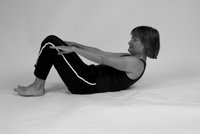
Due to the risk associated with vertebral fractures, this exercise is not advised for people with low bone density, osteopenia or osteoporosis. The crunch is one of a number of osteoporosis exercises to avoid.
There are many other exercises you can do to strengthen your abdominal muscles that are safe and do not place your spine at risk. These are covered in the Strength Exercises section of the Exercise for Better Bones program. This blog post lists several safer Abdominal Exercises for Osteoporosis.
You can also refer to my book, Strengthen Your Core, available in both Kindle and print formats, for a complete and safe program to strengthen your core.

2. Chest Fly
When using gym equipment, most women have to adjust their body position to accommodate the machines. The Chest Fly machine may cause undue stress on the vertebrae, possibly risking a compression fracture for people diagnosed with osteoporosis. I recommend you approach this exercise with caution.
3. Chest Press
When using gym equipment, this exercise (like its sister exercise, the Chest Fly) causes undue stress on the vertebrae, possibly risking a compression fracture for people with low bone density or osteoporosis.
I recommend that you avoid this piece of gym equipment altogether unless you can keep your spine in perfect postural alignment.
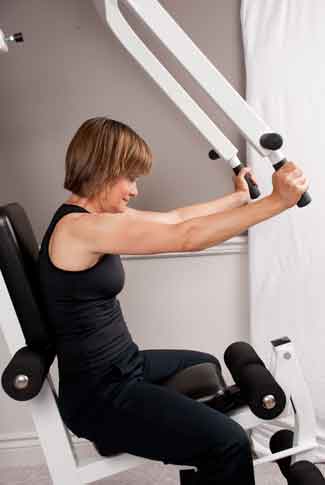
4. Knee Extensions
This exercise encourages a “slouched” posture, potentially risking a fracture of the vertebrae for people with osteoporosis.
If you are able to perform this exercise without the forward lean (the slouch position), then you should be okay with the exercise.
In my experience, most individuals find it difficult to maintain their posture while repeatedly doing this exercise and, over time, they gravitate back to the slouch position.
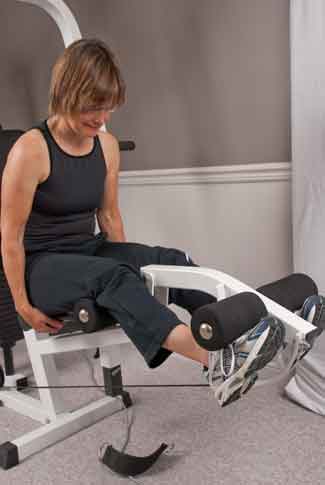
5. Lat Pull Down (Behind the Head)
Doing a lat pull down behind your head, as illustrated in the photo on the right, places excess stress on your shoulders, neck, and spine. I strongly advise that you do not do this exercise this way as it can cause a number of problems including shoulder pain. The lat pull down behind the head is one of a number of osteoporosis exercise contraindications.
A lat pull down, when done correctly, is an excellent exercise. The following are some simple instructions to follow for good “lat pull down” form.
- The bar should be pulled down in front of you, just below your chin.
- You should keep your breastbone high.
- Tuck your shoulder blades towards your pockets on the back of your pants as your elbows descend.
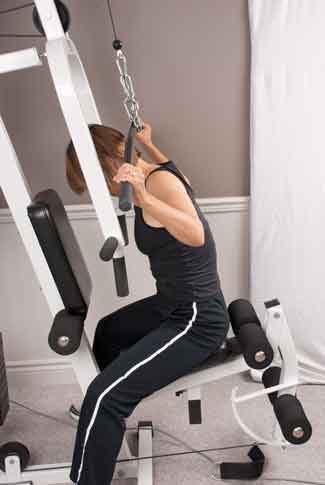
6. Seated Rows
This exercise, when done incorrectly, encourages a “slouched” posture, potentially risking a fracture to the vertebrae for people with osteoporosis. This slouch position is illustrated in the photo. Note the curvature of the upper back caused by the model leaning forward to follow the cord. This position should to be avoided.
This exercise can be performed safely when the person assumes a better posture – as illustrated in the picture. Note that the model has kept her posture straight and aligned. There is no forward lean or slouch.
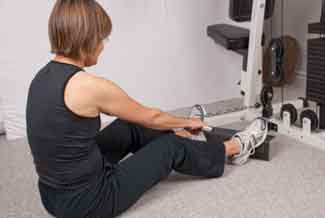
The challenge for most people will be to maintain a straight posture when they pull, pick up, and return the pulley to the rack. If you decide that this an exercise you want to keep in your routine, make sure that you maintain your posture throughout the execution of this exercise.
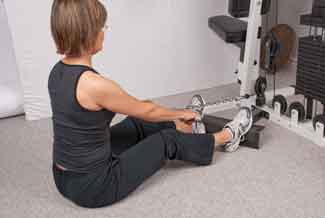
7. Toe Touch With A Twist
The toe touch with a twist is often the staple flexibility exercise in many Personal Training routines. The problem with this exercise is that it encourages a twist and bend in the spine, potentially risking a fracture to the vertebrae for people with osteoporosis.
This exercise is high up on the list of osteoporosis exercises to avoid because it combines both flexion and rotation. For most people, this exercise is best avoided altogether.
In this blog post on the hip hinge and standing forward bend, I explain why this movement is problematic. However, for those of you who insist on doing this exercise, I explain one way that you can safely modify the forward bend.
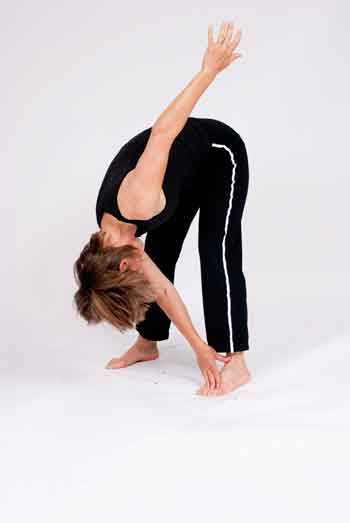
8. Hamstring Stretches
This stretch (and its variations) encourages flexion, potentially risking vertebral fracture for people diagnosed with osteoporosis. It is one of the more “popular” osteoporosis exercises to avoid.
The two photos illustrate common variations of this exercise.
The traditional hamstring stretch is frequently used to increase flexibility. Note that in the demonstrations, the model has a curvature of the back caused by the forward lean. This curvature or flexion needs to be avoided by people with low bone density and osteoporosis and is one of those osteoporosis exercises to avoid.
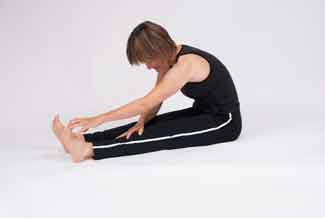
In the Flexibility section of the Exercise for Better Bones program, there are excellent and very effective hamstring stretches that do not put your spine at risk. Read this post on How to Stretch Your Hamstrings to learn safer and more effective ways to get flexible hamstrings.
I suggest you avoid the traditional hamstring stretch demonstrated on this page and instead use the exercises in the Flexibility section of the Exercise for Better Bones program.
The traditional hamstring stretch is one of a number of osteoporosis exercise contraindications and is one of those exercises to avoid with osteoporosis.
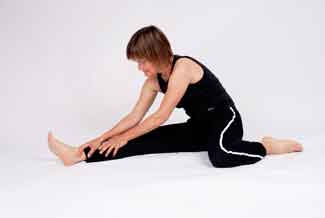
9. Back Stretches
This back stretch exercise position, illustrated in the photo, encourages flexion of the spine with a lot of loading – potentially risking vertebrae fracture for people with osteoporosis.
Since there are no modifications that can be made to this exercise to address its shortcomings, the exercise is best avoided. The back stretch is one of a number of osteoporosis exercise contraindications and is one of those osteoporosis exercises to avoid.
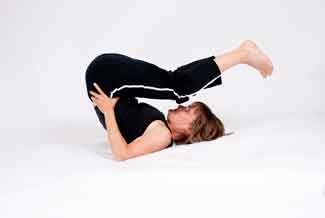
10. Osteoporosis and Cardiovascular Exercise Considerations
Good posture is important to maintain throughout your cardio routine. Osteoporosis exercise contraindications can happen while you perform weight bearing exercises.
Remember maintain proper posture and avoid positions that cause flexion of the spine while doing your cardiovascular (or weight bearing) exercises.
In the photo above, the model is deliberately slouching forward as she is using the cycling machine. She should change her seat position so that she maintains postural alignment while using the machine.
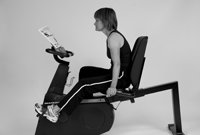
I encourage you read my blog post on modifications for gym exercises. You can also look at the video below:
Osteoporosis Physical Therapy Contraindications
I frequently encounter very motivated people who, without the guidance of a trained professional, select exercises that increase their risk of fracture instead of decreasing the risk.
For example, I recently had two male clients who had been diagnosed with osteoporosis in the last year. Both of these motivated and well-intentioned men started exercise programs because of the diagnosis.
Unfortunately, the self-prescribed exercise programs they were following increased their fracture risk! Some of the well intentioned, but potentially dangerous, exercise choices that these gentlemen made were:
Gym machines that encourage flexion.
This was especially true with the use of the preacher curl bench. This device forces your upper back into a rounded (or flexed) posture. At most gyms, this bench is the starting point for both the bicep curl and the tricep extension. The preacher curl bench forces you into a slouched position – a posture that is associated with increased compression fractures of the spine.
Crunches.
I strongly advise people with low bone density not to do this exercise because it places the subject in a flexed position. Crunches are frequently done either on a mat or on a machine and neither of these variations is safe. This exercise is frequently used by people to build abdominal strength. The MelioGuide Exercise for Better Bones Program has safer alternative exercises that build strength appropriate for people with low bone density.
Standing and seated hamstring stretches.
This is another popular exercise used during the flexibility phase of an exercise program. The major problem with the exercise is that it encourages flexion. This is one I suggest you avoid. Instead the MelioGuide Exercise for Better Bones Program has many safe alternative exercises for flexibility.
Bench press on a bench.
The problem with this exercise is that it is virtually impossible to safely get on and off a bench without flexing your spine. The situation is even more challenging when you perform the dumbbell bench press. The dumbbell bench requires that you hold two heavy weights as you get onto the bench. The same exercise on the floor would allow you to roll down through your side and avoid the flexed position. The MelioGuide Exercise for Better Bones Program includes a list of exercise safety tips to help you perform your exercise program in a safe fashion.
Elliptical machine for cardio.
The elliptical machine creates no ground force and, as a result, is does not challenge your joints and bones enough to stimulate bone building.
It also encourages flexion of the spine when performed improperly. Note in the picture that the client is having to slouch or flex forward to reach the handles.
There are many cardiovascular exercises that are safer alternatives to the elliptical. In the MelioGuide Exercise for Better Bones Program, I suggest a variety of safe cardio activities based on your activity level and fracture risk.
Recommended Modifications to Their Exercise Programs
After consulting with the two gentlemen, I made the following modifications to their exercise programs to make them more effective and safe for someone with osteoporosis. If you are following a program similar to their program and have low bone density, osteopenia or osteoporosis, you should consider these modifications as well.
Incorporate more free weights into your routine.
This allows a more functional type of lift. You are working the main muscle but also all the smaller supportive musculature. The added bonus that free weights deliver, when done with good posture, is that they allow your deep spinal muscles to kick in and help you build stronger bones in your spine (vertebra).
Focus on strengthening the transverse abdominus.
Other than martial artists, and competitive tennis, soccer and volleyball players, few recreational athletes need to develop their rectus abdominus. The rectus abdominus is the muscle strengthened by crunches.
Your focus when it comes to abdominal strengthening should be on the transverse abdominus. This muscle is your built in corset. It wraps around your torso and attaches into the fascia that is directly connected to your spine. Training your transverse abdominus will not only eliminate the potentially dangerous crunches from your program but it will also reduce dangerous torques and shearing forces that place your spine at risk.
Eliminate stretches that place you in a flexed position.
Lying flat on your back to stretch your hamstrings will reduce your tendency of bending forward at the spine to touch your toes.
Modify your bench press position.
Executing a bench press from the floor allows you to roll down and back up in a safer manner. With guidance, the use of a burst resistant ball also allows you to execute a bench press with safer ascent and decent. Replacing a bench press with a push up has the added benefit of increased loading through your wrists.
Select a safer cardio alternative.
Both men would benefit more from brisk walking either outdoors on the sidewalk or trail. When the inclement weather sets in, they could use the treadmill.
Exercise Recommendations for Osteoporosis
Exercise is an essential ingredient to bone health. If you have osteoporosis, therapeutic exercise needs to be part of your osteoporosis treatment program.
But what exercises should you do and which ones should you avoid? What exercises build bone and which ones reduce your chance of a fracture? Is Yoga good for your bones? Who should you trust when it comes to exercises for osteoporosis?
A great resource on exercise and osteoporosis is my free, seven day email course called Exercise Recommendations for Osteoporosis. After you provide your email address, you will receive seven consecutive online educational videos on bone health — one lesson each day. You can look at the videos at anytime and as often as you like.

I cover important topics related to osteoporosis exercise including:
- Can exercise reverse osteoporosis?
- Stop the stoop — how to avoid kyphosis and rounded shoulders.
- Key components of an osteoporosis exercise program.
- Key principles of bone building.
- Exercises you should avoid if you have osteoporosis.
- Yoga and osteoporosis — should you practice yoga if you have osteoporosis?
- Core strength and osteoporosis — why is core strength important if you have osteoporosis?
Enter your email address and I will start you on this free course. I do not SPAM or share your email address (or any information) with third parties. You can unsubscribe from my mail list at any time.
Pilates and Osteoporosis Exercise Precautions
Individuals with osteoporosis need to practice caution when doing certain Pilates poses and exercises. Before starting a Pilates program with a new student, a qualified Pilates instructor should gather important information about the student’s physical condition and health—including if the student has, or is at risk of, low bone density or osteoporosis.
If your instructor is not aware of your condition, then you should alert him or her and inquire about appropriate modifications before starting a Pilates program or session.
As a general rule, students should modify their Pilates programs as they progress in age. For the student with low bone density or osteoporosis, it is critical that the student and teacher monitor the student’s spinal alignment to reduce the risk of vertebral fracture.
Forward bends of all kinds should involve flexion of the hip only. Students need to maintain a normal curvature of the spine throughout the pose. Bending at the hips, rather than at any point in the spine, is essential. Pilates instructors need to be aware of the risks to clients with low bone density of forward bends that involve spinal flexion. Modify or eliminate poses that cause negative stresses on the spine.
Certain Pilates poses can increase the risk of vertebral fracture for people with low bone density or osteoporosis. Pilates poses that involve forward flexion of the spine need to be modified or avoided. Avoid or modify these Pilates poses for clients with osteoporosis:
- Hundred
- Spinal rotation
- Roll up
- Spine twist
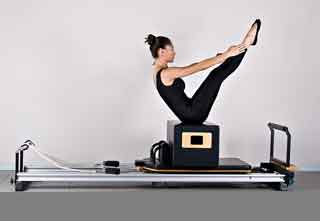
Yoga Osteoporosis Exercises to Avoid
Certain exercises, including some yoga and Pilates poses, can cause strain on the vertebrae of a person with osteoporosis — to the point where the risk of a compression fracture is quite high. As a result, certain yoga and Pilates poses need to be modified or avoided for people with osteoporosis.
My book, Yoga for Better Bones, is about yoga exercises for osteoporosis and specifically identifies osteoporosis exercise contraindications and poses that should be modified or avoided for people with osteoporosis.
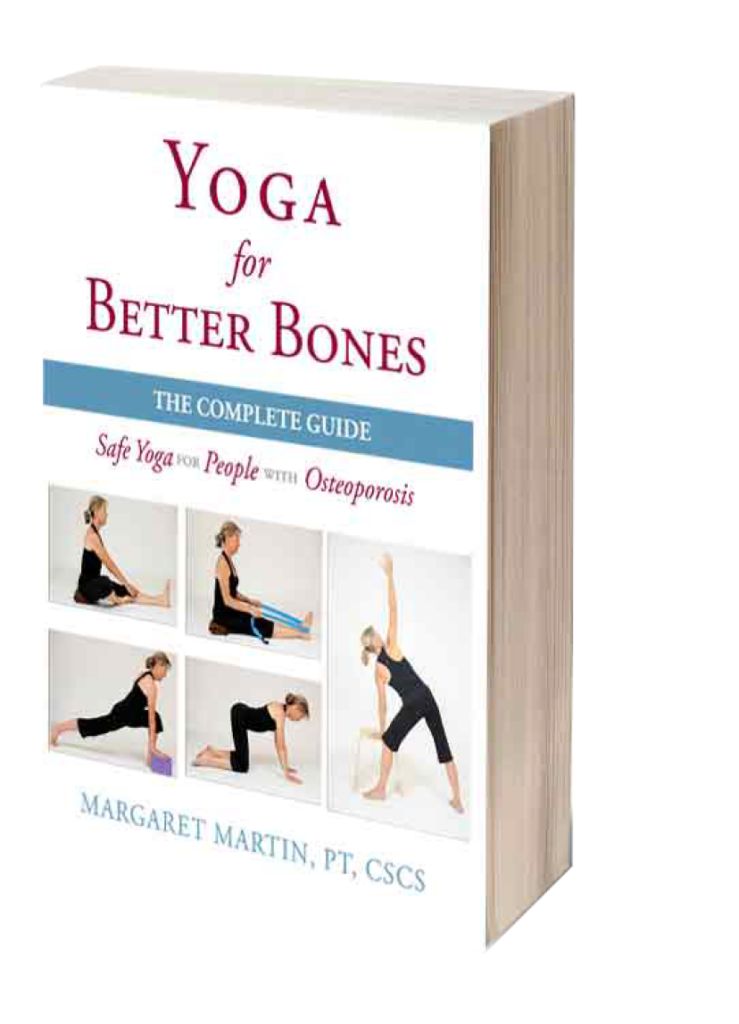
Exercise for Better Bones
I am sure that you have done some of these osteoporosis exercises to avoid at one point in your life. Time to move onto an exercise program that builds bone strength and reduces the risk of fracture.
In Exercise for Better Bones I cover, in detail osteoporosis physical therapy contraindications exercises as well as exercises you should do to that are safe and effective for your activity level and fracture risk.
I encourage you to embark on your Exercise for Better Bones program!
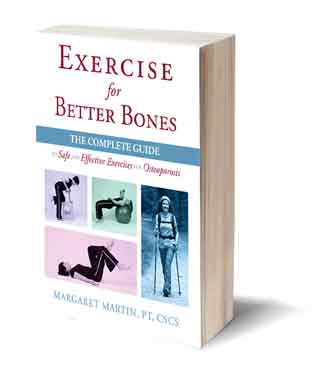
Osteoporosis Exercise Plan
Visit my Osteoporosis Exercise Plan page for more information on this topic.
Osteoporosis Exercises to Avoid • Conclusion
After reading this you should know the major osteoporosis exercises to avoid and understand osteoporosis exercise contraindications.

Comments
January 15, 2018 at 10:09pm
Anne Hogan
Such a helpful website. Thank you. This section on exercises to avoid is critical. I was doing them for years in my youth and middle years and gradually dropped them from my routines as I learned more about their negative effects. Now that I have been diagnosed with osteoporosis, I'm on the hunt for a physio in my northern BC community who can guide my exercise program. In the meantime I will be learning and practicing as much as possible from you via this website. Thank you again.
January 17, 2018 at 9:43pm
Margaret Martin replies
Glad you found this section helpful. It is unfortunate that so many senior classes and still incorporate unsafe exercises. You may find some help finding a physio through: www.bcwomens.ca/our-services/population-health-promotion/osteofit/
All the best.
Margaret
January 29, 2018 at 11:24am
Emma
Please tell me if I can do your exercises when I already have fractures.
February 21, 2018 at 9:17pm
Joyce Groot
Thank you again Margaret..I did these exercises often, but delete them quickly. Especially now that I use your book and exercises on strengthening my bones.
February 21, 2018 at 9:15 P.M.
March 11, 2018 at 12:53pm
Anita
Are those exercises also contraindicated for OSTEOPENIA of spine? Or should I keep doing them to MAINTAIN flexibility & Strength?
March 11, 2018 at 6:51pm
Margaret Martin replies
Anita, Great question! The thing is that the diagnosis of osteopenia and osteoporosis is only based on your bone mineral density scores. Your bone quality is not taken into account.
Some individuals with higher bone density but poorer bone quality are more at risk of fracturing than someone with lower bone density and higher bone quality. Since your diagnosis or osteopenia only tells you about your bone density it is important to consider the factors that affect your bone quality. I have a great blog about bone quality: http://melioguide.com/osteoporosis-prevention/bone-quality-osteoporosis/
To be on the safe side I would find safer, more intelligent ways to stretch your hamstrings, strengthen you quads, etc all are detailed in my books.
Keep well.
March 19, 2018 at 9:48pm
Pat Anderson
Hi Margeret,
Although you and other professionals recommend Tai Chi for individuals with osteoporosis, I have a concern with a spine turning foundation from the Taoist Tai Chi tradition that is also incorporated into many movements of the set. The object of the movement is to turn the shoulders before the hips in a spiraling movement of the torso as you transfer weight forward. For someone with significant osteoporosis of the lumbar spine I am concerned about doing this move. Otherwise, I do love my Tai Chi. Any thoughts about this movement?
I have been using your book of exercises for the past year and thank you for them.
Pat
March 21, 2018 at 4:21pm
Margaret Martin replies
Hi Pat,
The amount of rotation you mention is not so great that you need to be concerned. Having said that, if it does not feel right for you or does concern you then modify it so that you can feel safe and at peace with your practice. Of bigger concern to me is the "Needle at the Sea Bottom". Be sure to stick out your bottom and hinge from your hip when doing this move. Thank you for your support in purchasing my book. Wishing you many happy hours of TaiChi practice.
Margaret
May 27, 2018 at 8:29pm
Jill
What about running? I'm recovering from a stress fracture of my large toe. I'm a fifty year old woman. A dexa scan revealed osteopenia. My doctor says I can continue running after it heals. I found your article while searching for safe exercises during my recovery. After too! :) What confuse me though is some articles like this one - says not to run. Others like Mayo and WebMD say its OK. Is it OK to run with osteopenia but not with osteoporosis?
May 28, 2018 at 6:45am
Richard Martin replies
Hi Jill
Margaret covers discusses your question in this blog post: http://melioguide.com/osteoporosis-exercises/running-and-osteoporosis/
August 24, 2018 at 1:09am
wendy holbrook
Is cycling ok? I'm an avid cyclist and was just told I have osteoporosis of the lumbar and osteopaninic of the hips. I can't imagine giving it up.
August 26, 2018 at 3:49pm
Margaret Martin replies
Hi Wendy, Cycling is an excellent form of cardiovascular exercise that is easy on your hips and knees. Just do not expect it to help your bones. Make time in your weekly exercise routine to do bone building strength and weight bearing exercises.
October 20, 2018 at 3:20pm
Stacy
What is your opinion of trap bar deadlifts and prowler exercises (specifically pushing) for someone who is strong and fairly well-conditioned who has been diagnosed with osteoporosis?
October 21, 2018 at 11:12pm
Margaret Martin replies
Hi Stacy,
I will comment on the exercises you ask me about but I want to be sure that you are not working out in a low energy state. There is a condition referred to as the athlete triad syndrome. It is common in lean athletes such as female body builders, dancers, gymnast and distance runners. In an effort to reduce their body fat so much they develop menstrual dysfunction (amenorrhoea/oligomenorrhoea). The third leg of the triad is low bone density. If this is the cause for your osteoporosis I strongly encourage you to seek medical help.
Being diagnosed with osteoporosis is like being painted with a very broad brush. It does not give me any idea of how low your bone density is. Nor what your bone quality is like (previous fractures, your posture, medication history, past eating disorders, age of menarchy etc. ) all are part of my decision making when someone asks me whether or not they can do particular exercises.
Prowler
Done from the higher position with a straight back I might be comfortable with it (as in the blog below). I would not be comfortable with you turning the sled.
https://www.youtube.com/watch?v=Ib9O1kD6bUI
Deadlift
The deadlift was used in the LIFTMOR study with osteoporotic woman.
https://www.ncbi.nlm.nih.gov/pubmed/28975661
As mentioned in the study all lifts were highly supervised. I recently spoke to the lead researcher in the LIFTMOR and she said there has only been one vertebral fracture to date. It occurred after the publication of the study results.
As far as insuring good form I respect Jeff Cavaliere and encourage you to look at his instructions to be sure you are keeping yourself safe:
https://www.youtube.com/watch?v=hCDzSR6bW10
As far as Straight bar vs Trap bar, I do not have any personal experience however:
Tony Gracia in his blog writes: "Benefits of the trap bar are that it has a smaller learning curve, it is more accommodating to lifters that have low mobility, and it can be helpful in teaching leg drive. Long term success with deadlifts using a barbell is dependent on learning to use the hips well (both for mobility and strength)."
My concern if you are following the form put out in Athlean X is "The “lockouts”, or finish positions, of the lifts, also have subtle differences. In both cases, you should be standing up tall with a neutral spine, and your glutes squeezed tight and knees locked. The difference is that while the straight bar is pulled in tight against your upper thighs, the trap bar is not braced against your body, sometimes resulting in the weight swinging a little bit. This makes the finish position of the straight bar more stable than that of the trap bar."
Source: https://www.onnit.com/academy/how-to-deadlift-straight-bar-vs-trap-bar/
Lift safe. Take care.
Margaret
December 12, 2018 at 2:20am
Meera
Hello Margaret,
Any advise on excercise like single leg slide and single leg circles. These are Pilates based.
Thank you.
Meera
December 14, 2018 at 5:58am
Margaret Martin replies
Hi Meera, Thank you for asking your question. I can only comment on things I see and so referring to the demo on this link: https://www.youtube.com/watch?v=pg4WRNkbnjA
what I see despite what the instructor is saying is that the person demonstrating is straining her low back with every "circle" or leg drop. You can see this if you look at the arch in her low back as she moves her leg. Placing a rolled towel in arch of the lower back is one way to get tactile feedback that you are keeping your spine stable while moving the leg. Bending the opposite leg with the foot resting on the floor could also reduce the strain on the low back.
So in this case it is less about the flexion strain placed on the spine and more about the shearing stresses if you are not stable enough which the model was in my opinion demonstrating. Hope this is helpful.
All the best,
Margaret
July 23, 2019 at 10:27pm
Sheila Mooney
Margaret, I'm wondering what medications do you recommend for osteoporosis. My T scores are quite low.
Thanks: Sheila
July 25, 2019 at 9:15am
Richard Martin replies
Hi Sheila. This is a discussion you should have with your physician. In the meantime, you should read the following blog posts. They will help you with your conversation with your physician. Good luck.
http://melioguide.com/osteoporosis-treatment/how-long-can-you-take-prolia/
http://melioguide.com/osteoporosis-treatment/bisphosphonates-osteoporosis-guidelines/
http://melioguide.com/osteoporosis-prevention/bioidentical-hormone-replacement-therapy/
October 4, 2019 at 1:13am
Jaya
Hi, Margaret,
I'm a 67 year old woman with osteoporosis. I just discovered your website a couple of weeks ago and have been enjoying it and learning a lot. I'm planning now to get "Exercise for Better Bones". I recently started physical therapy for painful tightness in my back in the thoracic region. The PT has given me a number of different exercises to do at home. One of them is the "Side-Lying Thoracic Rotation with Open Book." I was concerned this might not be safe for me because of the spinal rotation that's involved. Would very much like your opinion on this.
Thank you!
Jaya
October 8, 2019 at 10:05am
Margaret Martin replies
Hi Jaya, I am glad you discoed us!
I like the side-lying thoracic rotation exercise. Rotation in side-lying is safer since you do not have the weight of your head and shoulders on your spine.
There are two modifications I insist on with my osteoporosis clients:
1.I encourage clients to use a pillow behind your back. This will allow you to rest your back into the pillow as you rotate back rather than "hang in the air". As you get more flexible you can use a thinner pillow.
2. Align your head and spine so that your top ear, shoulder and hip in a straight line (avoid going into a fetal position).
It sounds like you are in good hands. Please share the suggestions with your therapist to be sure they are suitable for you.
All the best,
Margaret
November 12, 2019 at 5:41pm
Hillary
Margaret,
I was a runner for years, but struggled with eating disorders until recently, now 53. I've lifted weights for the past 5 years, and this probably saved my bones, as I have osteoporosis, mainly as a result of poor nutrition my whole life. I'm working to regain my nutritional health, get to a healthier weight, and still continue working out, which I love very much. I do 1 hour of elliptical and 1 hour of lifting every day. I rarely vary my lifting routine, but I've started to do so, focusing on specific exercises for osteoporosis, and avoiding the harmful ones. Your videos are fabulous.
I have started taking 1000mg Calcium and Vit D, 1 hour before exercising as I heard it prevents a drop on Ca during exercise which leads to higher PTH and bone resorption. I don't know if you've heard of this before.
My question is, is it okay to do 1 hour of elliptical a day. I love the endorphin rush, and use proper form. I follow this with my lifting routine. My muscles are great, but I am very much underweight. Any guidance is appreciated. I would also like to obtain some of your resources. Which programs do you recommend, since I'm at a high level of fitness, but need some direction.
Thank you,
Hillary
November 18, 2019 at 9:39pm
Margaret Martin replies
Hi Hillary,
Thank you for reaching out. I will contact you through your email address. There are many changes that you need to make to optimize your bone health.
Margaret
November 29, 2019 at 7:17am
Martin
Hi Margaret,
What do you think of kettlebells, specifically the kettlebell swing? I apologise if this has been answered elsewhere.
Thanks
Martin
December 1, 2019 at 4:30pm
Margaret Martin replies
Hi Martin, Thank you for your question. It is a good one and has not yet been covered elsewhere. I will do a future blog but it may be months before it is published.
Here is a short summary:
A review of the studies on the kettlebell swing indicate a large mechanical demand during the kettlebell swing exercise. All studies involved healthy young men with previous kettlebell experience.
A 2019 review of the kettlebell as a therapeutic tool state that "there were only a small number of longitudinal studies, which are largely underpowered and of low methodological quality". They conclude that "the current studies provide the evidence-informed therapist with little guidance to inform the therapeutic prescription of kettlebells."
In a nutshell, evidence points to the use of kettlebells as an effective loading tool in healthy young men however it is not something I would be comfortable prescribing due to the potentially harmful shear loads that it can place on an osteoporotic spine.
I hope this answer is helpful. Thank you for asking it.
Margaret
January 8, 2020 at 6:41pm
Jill Cantrell
Hi Margaret,
I'm 53 with -2.7 of hip and -2.1 of lower spine and other hip. My physician said it's ok to play pickleball. I am wondering what I need to avoid while playing. I do lean over to hit the ball and may twist the spine on the serve or hits.
Thank you,
Jill
January 9, 2020 at 1:12pm
Richard Martin replies
Hi Jill. Margaret cannot comment on someone's individual situation without an assessment. In general, you will find the guidelines on this page to be useful. http://melioguide.com/health-guides/osteoporosis-guidelines/osteoporosis-exercise-plan/
January 12, 2020 at 6:01pm
Margaret Martin replies
Hi Jill, Thank you for reaching out.
I just had a client who fell breaking her wrist on a pickle ball court. Hopefully you have court that is not asphalt. Since your BMD scores are lowest in your hip, a precaution would be to wear hip protectors http://melioguide.com/osteoporosis-exercise-equipment/hip-protectors/. Also, be sure to work on your balance exercises.
Margaret
September 1, 2020 at 9:53pm
Victoria Barkoff
Are you familiar with Classical Stretch (Essentrics)? The movements are slow and relaxed, but there is some twisting and flexion. My body feels good doing this program but I am concerned that I am at risk of injury because of my osteoporosis.
September 2, 2020 at 12:35pm
Richard Martin replies
Hi Victoria. If you are concerned with the health of your bones, you should avoid the movements listed in this blog post.
October 15, 2020 at 2:30pm
Chicken Little
"Too soon old; too late smart," as the Yiddish saying goes. At 71, and osteopenic for years, I have been so happy to find this informative site. I'm now taking the free exercise course, and will definitely order the book.
But, OMG, now I see I have been (enthusiastically) doing all these bending and twisting "exercises to avoid" for the past 2 years while my lumbar spine has continued to decline (to -2.2 at the most recent DEXA). I was so elated to see that my hip BMD had reversed (presumably from all the 20,000 steps/day dancing I have been doing), I failed to notice the fine print that said "progressive multilevel degeneration is now necessitating exclusion of L3 and L4." So it appears my spine is the weakest link, and if I haven't done myself any damage (and I don't have any back pain so far), I must be living under a lucky star.
By luck I have done a few things right (topical HRT, attention to posture and stretching feet and calves, correcting low Vitamin D), but there are so many other things I can see will need to change, from my choice of resistance exercises to how I take a turkey out of the oven. Thank you for assembling such a comprehensive collection of scientific and practical information about bone health. Applying this advice will keep me busy into next year.
October 15, 2020 at 3:09pm
Richard Martin replies
You are welcome.
February 20, 2021 at 4:02pm
Donna
Hi Margaret.
I’m 39 years old and just found out I have osteoporosis. I also have scoliosis with 2 spinal fusion surgeries. Any tips?
February 21, 2021 at 8:01am
Richard Martin replies
Hi Donna. Margaret recommends you consult with a skilled and experienced physiotherapist.
July 13, 2021 at 9:06pm
Bev
Margaret I just bought your book. I have just a week ago been diagnosed with osteoporosis in the right femur. Do you know if you can use a tennis ball on tight muscles with osteoporosis? Thank you
January 1, 2022 at 6:52am
Ghaleb Abu arga
Supine Open book drill , to improve thoracic Spine mobility is it good for a 59-year-old woman suffers from osteoporosis of the vertebrae (l1 l4) of score - 3.9??
April 14, 2022 at 2:28pm
Kim
Hi Margaret,
I am a 64 year old woman just diagnosed with osteoporosis. I enjoy a variety of exercise and wonder if I should continue to use my rebounder.
April 16, 2022 at 11:11am
Richard Martin replies
Hi Kim. Here is Margaret's position on the rebounder. Devotees of the rebounder might not like her position on the rebounder vis-a-vis bone health ... but we have to follow the science and there is none supporting it's efficacy improving bone health. http://melioguide.com/osteoporosis-exercise-equipment/rebounder-review-build-bone/